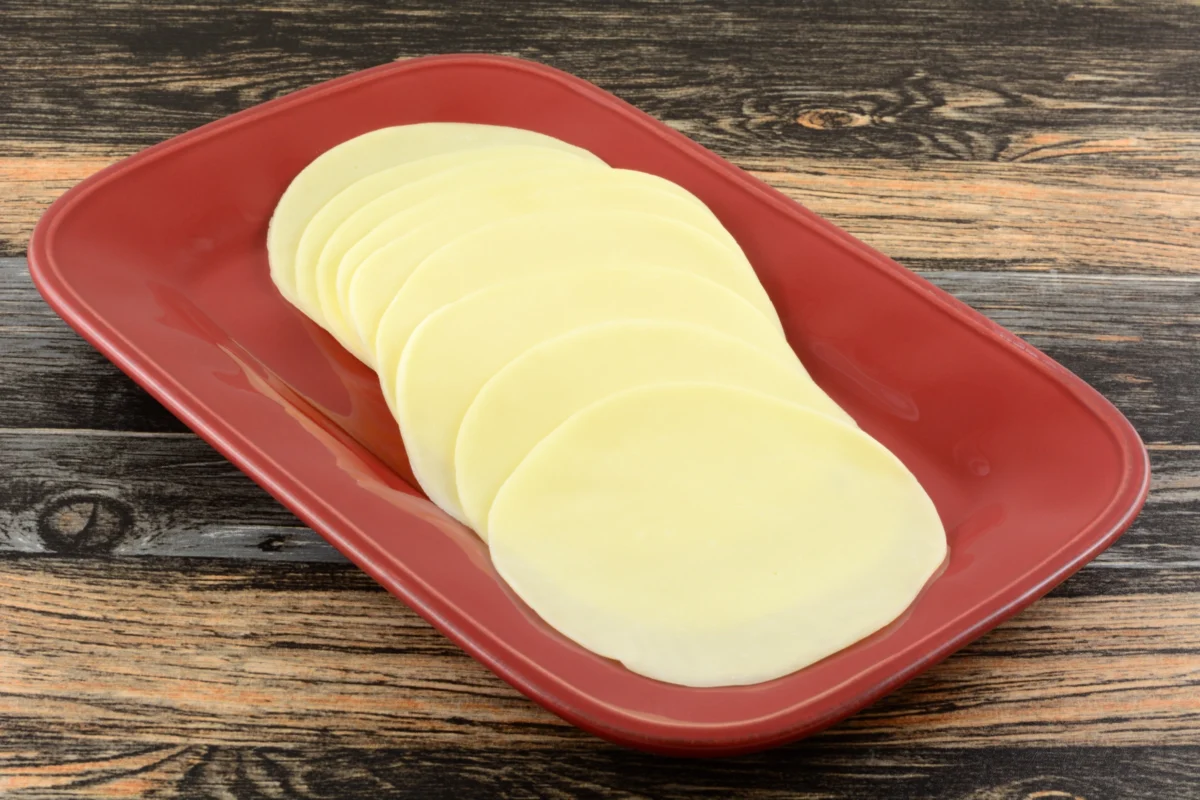Have you ever wondered, “Can dogs eat provolone cheese?” It’s a question that crossed my mind when I welcomed Daisy, my lively Golden Retriever, and Gunner, my playful Goldendoodle, into my home. These two pups have their quirks when it comes to food, but one thing they never turn their noses up at is provolone cheese.
Provolone Cheese: A Medication Trick
Let me share a little secret with you. Giving Daisy and Gunner their medication used to feel like an Olympic sport. Picture this: Me, trying to convince Daisy, who thinks she’s playing hide-and-seek, while Gunner watches, probably relieved it’s not his turn this time.
During one of these struggles, I discovered a game-changing solution—provolone cheese. I would simply wrap their pills inside a slice, and like magic, the medication was swallowed without a hitch. Now, every time I take out provolone from the fridge, I have two pairs of eager eyes watching my every move, hoping it’s time for medicine.
Isn’t it fascinating how our fur babies make the most unexpected things feel special?
The Charms of Provolone Cheese
Originating from Southern Italy, provolone cheese takes me on a journey to my Italian roots with every bite. Made primarily from cow’s milk, this semi-hard cheese is pale yellow in color with a firm, yet yielding texture.
Crafting provolone cheese is an art deeply rooted in tradition. Fresh milk is curdled and then meticulously molded into distinct shapes, often resembling pears or cones. The aging process can range from a few months to over a year.
So, when I indulge in provolone, it’s not just cheese—it’s a cherished connection to my Italian heritage.
Nutritional Facts About Provolone Cheese
Let’s delve into the nutritional content of provolone cheese that you might want to consider before sharing it with your furry friend.
- Calories: A standard slice of provolone contains approximately 98 calories.
- Fat: Provolone has about 7.5 grams of fat, so it should be given in moderation to avoid weight gain.
- Sodium: With around 250 milligrams of sodium per slice, provolone is on the higher end. Too much salt is not beneficial for dogs.
- Protein: Provolone offers a decent protein kick with nearly 7 grams per slice.
Compared to other cheeses, provolone has its advantages and disadvantages. It has less fat than cheddar but more sodium. Mozzarella has lower sodium levels but less protein. Gouda has slightly more protein than provolone. Moderation is key when sharing provolone with your dog.
The Benefits of Provolone Cheese for Dogs
Who doesn’t love a delicious cheese treat? Our four-legged pals certainly do. Let’s explore why cheese, in moderation, can be a delightful and beneficial reward for our furry companions.
High-Value Reward
Seeing our pet’s eyes light up at the sight of a treat brings joy to every dog owner. Cheese, with its rich and tangy flavors, can be a high-value reward. Its texture and aroma can get tails wagging in no time, making it perfect for training sessions or special bonding moments.
Calcium-Rich Goodness
Cheese is a natural source of calcium, essential for strong bones and teeth. For growing pups, a bit of calcium can support their skeletal development. However, like with children, moderation is key to prevent overconsumption.
Packed with Protein
Protein is crucial for muscle growth, repair, and overall health. Cheese, including provolone, offers a tasty way to supplement your dog’s protein intake.
So, it’s tempting to shower our dogs with cheesy love, but remember to share a slice thoughtfully. Health and happiness go paw in paw!
Risks of Provolone Cheese for Dogs
As much as our dogs might drool over provolone cheese, it’s essential to be aware of the potential risks. Let’s discuss some reasons why cheese may not always be the ideal treat for every pup.
Lactose Intolerance
Just like humans, dogs can be lactose intolerant. Some dogs are unable to break down lactose, leading to digestive upset. Pay attention to symptoms such as diarrhea, gas, or vomiting after giving your dog cheese.
Sodium Overload
Provolone, as mentioned earlier, can be high in salt. Consistently feeding dogs salty treats can lead to increased thirst, increased urination, and, in severe cases, sodium ion poisoning.
The Fat Factor
While some fat is beneficial, excessive amounts can lead to weight gain and an increased risk of pancreatitis, a painful and potentially serious condition. Monitor your dog’s fat intake, including cheese treats.
In the grand scheme of things, balance is key. Occasional cheese treats are likely okay for most dogs, but always be mindful, observe for signs of intolerance, and remember that moderation is the mantra for doggy treats!
Provolone Cheese as a Medication Wrapper: The Dog Owner’s Hack
Getting our furry pals to swallow pills can be challenging. But cheese? That’s a game-changer.
The Allure of Cheese
Using cheese as a pill disguise is a trick as old as time. The rich, creamy texture is not only a hit taste-wise, but it’s also perfect for molding around a pill or supplement.
Bye-Bye Bitter Pills
One of the main struggles with medication is the taste. Some medications have a bitter or unpleasant taste. Cheese effectively masks the unpleasantness of the pill, turning medicine time into a drool-worthy treat.
Easy Swallow, Happy Pup
The softness of cheese makes the pill-swallowing process smoother. There’s no hard capsule or tablet to contend with—just a cheesy bite that goes down the hatch with ease.
To all the dog parents out there: if you haven’t tried the cheese trick, give it a shot. It could make medicine time a whole lot cheerier for both you and your fur baby!
Provolone Cheese vs. Other Cheeses
When it comes to treating our dogs, a variety of cheese options are available. Let’s compare how provolone stacks up against other canine crowd-pleasers like cheddar, mozzarella, gouda, and swiss.
Provolone: The Italian Staple
Provolone, with its distinctive flavor and texture, is a protein-packed cheese that’s rich in calcium. However, be mindful of sodium and fat intake when giving it to your furry friend.
Cheddar: The Bold Classic
Cheddar is flavorful and often lower in lactose, making it a potentially safer pick for dogs with sensitive digestive systems. However, it has a higher fat content.
Mozzarella: The Gentle Delight
Mozzarella is known for its softness and mild taste. It has lower sodium levels, making it a potentially safer option for regular treats.
Gouda & Swiss: The Continental Duo
Gouda is rich in both flavor and protein, slightly edging out provolone. Swiss has balanced fat and sodium levels, making it a well-rounded option.
Remember, every dog is unique. While one might gobble up Gouda with glee, another might prefer the milder taste of mozzarella. Observe, experiment in moderation, and find what suits your pup’s palate and tummy best.
General Tips for Giving Provolone Cheese to Dogs
Sharing cheese with our dogs is delightful, but it comes with responsibilities. To ensure our pets enjoy this treat safely, let’s establish some ground rules.
It’s All About Balance
Cheese is delightful, but moderation is essential. A bite or two is a treat, but too much can lead to overindulgence for our furry friends.
Tread Gently with New Varieties
Introducing your dog to a new cheese? Take it slow. Start with a small piece and observe how their stomach reacts before giving more.
Allergy Alerts: Know the Signs
Dogs can exhibit signs of allergies or intolerances just like humans. After feeding them cheese, watch for signs such as excessive scratching, redness, swelling, or digestive upsets. If you notice any of these signs, stop giving cheese treats and consult a vet.
Serving cheese to our dogs is a mix of joy and responsibility. As long as we’re attentive and informed, it can be a delightful experience for both pets and owners!
Conclusion
Cheese, with its creamy texture and irresistible taste, is undoubtedly a favorite among many, including our dogs. From the sharp tang of cheddar to the mild caress of mozzarella, and of course, provolone, there’s a world of cheesy options out there.
However, it’s essential to be guided by knowledge and care. Understanding the nutritional aspects, recognizing the benefits, and being mindful of potential risks will ensure that cheese remains a delightful, occasional treat rather than a health concern.
For Daisy, Gunner, and all our pets, these small indulgences symbolize more than just treats. They represent shared moments, bonding, and love. Let’s continue to make these moments memorable, always prioritizing our pets’ health and well-being.
Frequently Asked Questions
Q: Can dogs eat provolone cheese?
Yes, dogs can eat provolone cheese in moderation.
Q: What are the risks of feeding provolone cheese to dogs?
Some risks include lactose intolerance, sodium overload, and excessive fat intake.
Q: How can I use provolone cheese as a medication wrapper?
You can wrap pills or supplements in provolone cheese to make it easier for your dog to swallow them.
Q: What are some alternative cheese options for dogs?
Other cheese options include cheddar, mozzarella, gouda, and swiss. Each cheese has its own characteristics and nutritional profile.
Q: How should I give provolone cheese to my dog?
Provolone cheese should be given in moderation as a treat. It is essential to monitor your dog for any signs of allergies or intolerances and adjust their diet accordingly.
Q: Can cheese be a high-value reward for dogs?
Yes, cheese can be a high-value reward for dogs due to its rich and tangy flavors. It can be used during training sessions or as special bonding moments with your pet.

